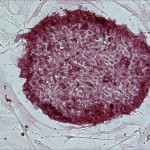 Within five years, likely well before we start treating patients with their own genetically corrected stem cells created from induced pluripotent stem cells, I am expecting to see new drugs discovered using iPS cells enter the clinical pipeline.
Within five years, likely well before we start treating patients with their own genetically corrected stem cells created from induced pluripotent stem cells, I am expecting to see new drugs discovered using iPS cells enter the clinical pipeline.
It’s only been two years since three labs (ours included) created the first human iPS cells through genetic reprogramming of skin cells. Since our creation of the first repository of disease-specific iPS cells in 2008, the number of diseases being modeled in iPS cells has increased to dozens worldwide.
Most of us are starting with well-defined disorders that are caused by mutation of a single gene, where we know with certainty the specific cell types and tissues affected by the disease process, and feel fairly confident that we can at least partially recreate that disease in a dish. In such diseases, which include immunodeficiency disorders, sickle cell anemia, and Parkinson disease, the act of differentiating iPS cells from an affected patient allows us a snapshot of the earliest pathological events.
We can then compare the behavior of normal and diseased cells in a petri dish, and screen for drugs that normalize the diseased cells. This strategy, applied to the actual human cells affected by the disease, promises to be much better than animal testing at predicting the efficacy of drugs – and, conversely, their toxicity.
Recently, for example, scientists at iPierian, a company I founded, used iPS cells to test a few dozen compounds that had shown promise in animal models of spinal muscular atrophy, but that ultimately didn’t work in patients with this progressive, muscle-weakening disease. Their experiments revealed the reason: when neurons made from patients’ iPS cells were exposed to the drugs, the diseased cells didn’t return to normal, and in some cases the drugs actually proved toxic to the cells.
Promising disease areas for drug-screening applications include blood diseases, for which we now have many iPS cell lines, diabetes and retinal disease. Recently, a German team created iPS cells from patients with long-QT syndrome, a condition that can cause heart rhythm problems. This group directed the iPS cells to differentiate into beating cardiac myocytes, and showed that the heart cells showed the same rhythm disturbance in a petri dish as in the patient. Furthermore, they showed that beta-blocker drugs, which are used to treat patients, also protected the cells in the dish. This is an important demonstration that patient-specific iPS cells will be helpful for testing drugs.
By testing drugs on specific cells and tissues created from iPS cells, we can even predict a patient’s individual response to a treatment — realizing the vision of personalized medicine. I expect the explosion of disease-specific iPS cells will greatly speed up drug discovery, beginning with the rare, single-gene diseases but ultimately giving us a new strategy for finding drugs against more complex conditions like Parkinson’s, Alzheimer’s and diabetes.
Does this mean embryonic stem cells are no longer needed for disease modeling and drug screening? No. Certain diseases, such as Fanconi anemia, have to date been more effectively modeled using embryonic stem cells. In addition, there are conditions that involve gene defects that lead to gene silencing, such as Fragile X syndrome, and we recently showed that these are modeled more faithfully with embryonic stem cells.
In recent weeks, we’ve been riding a roller coaster, with ups and downs based on judgments in a Federal court case challenging the policy for funding of human ES cell research. Although federal funding for embryonic stem cell research has temporarily been put back on track, the landscape is still in flux and I fear our research funding could be halted at any time. I hope embryonic stem cell research remains an option, because it is a vital part of finding new medicines for the future.
[Editor's note: Daley will discuss disease modeling with pluripotent stem cells at a forum at Harvard Medical School, Monday, Sept. 27.]






